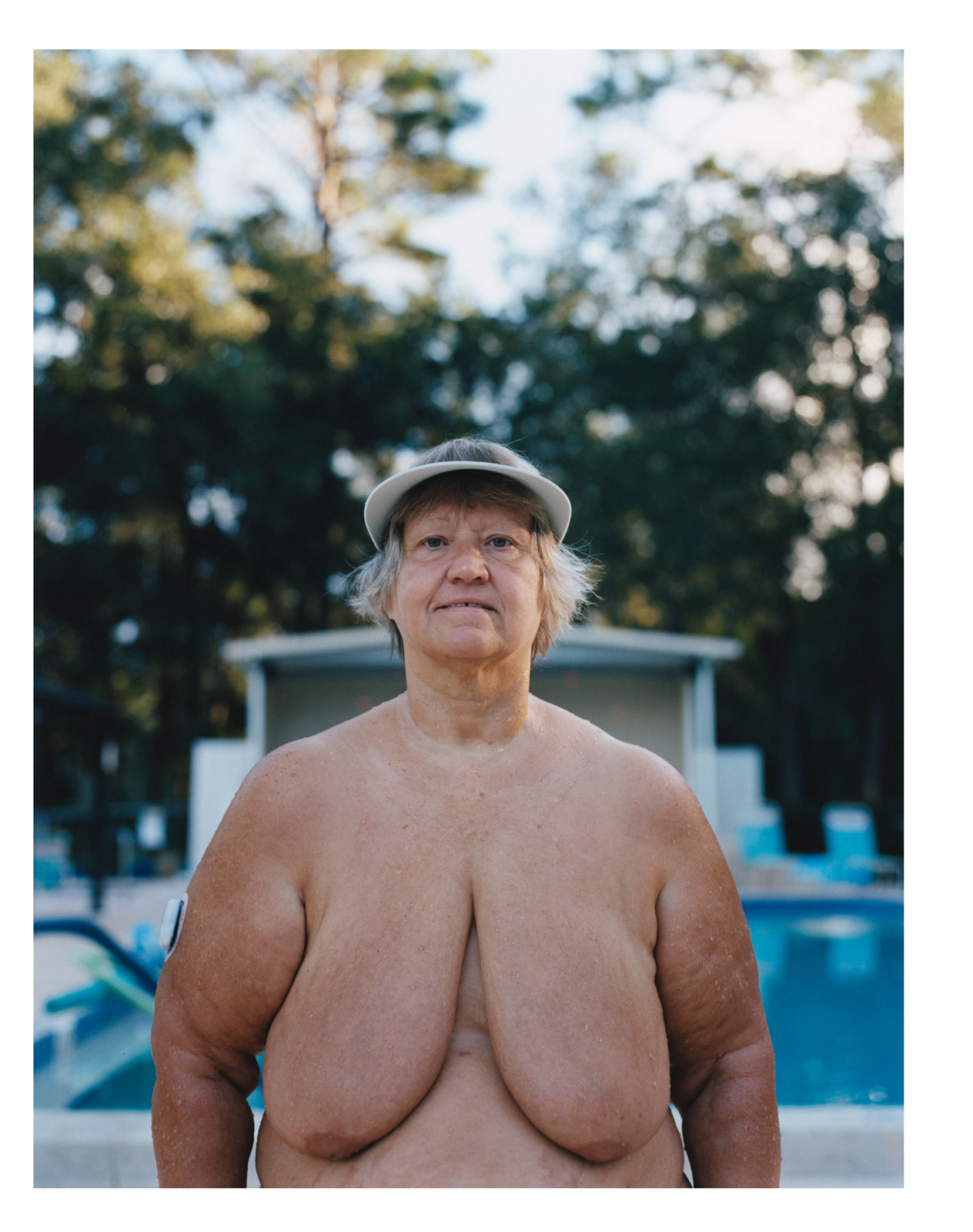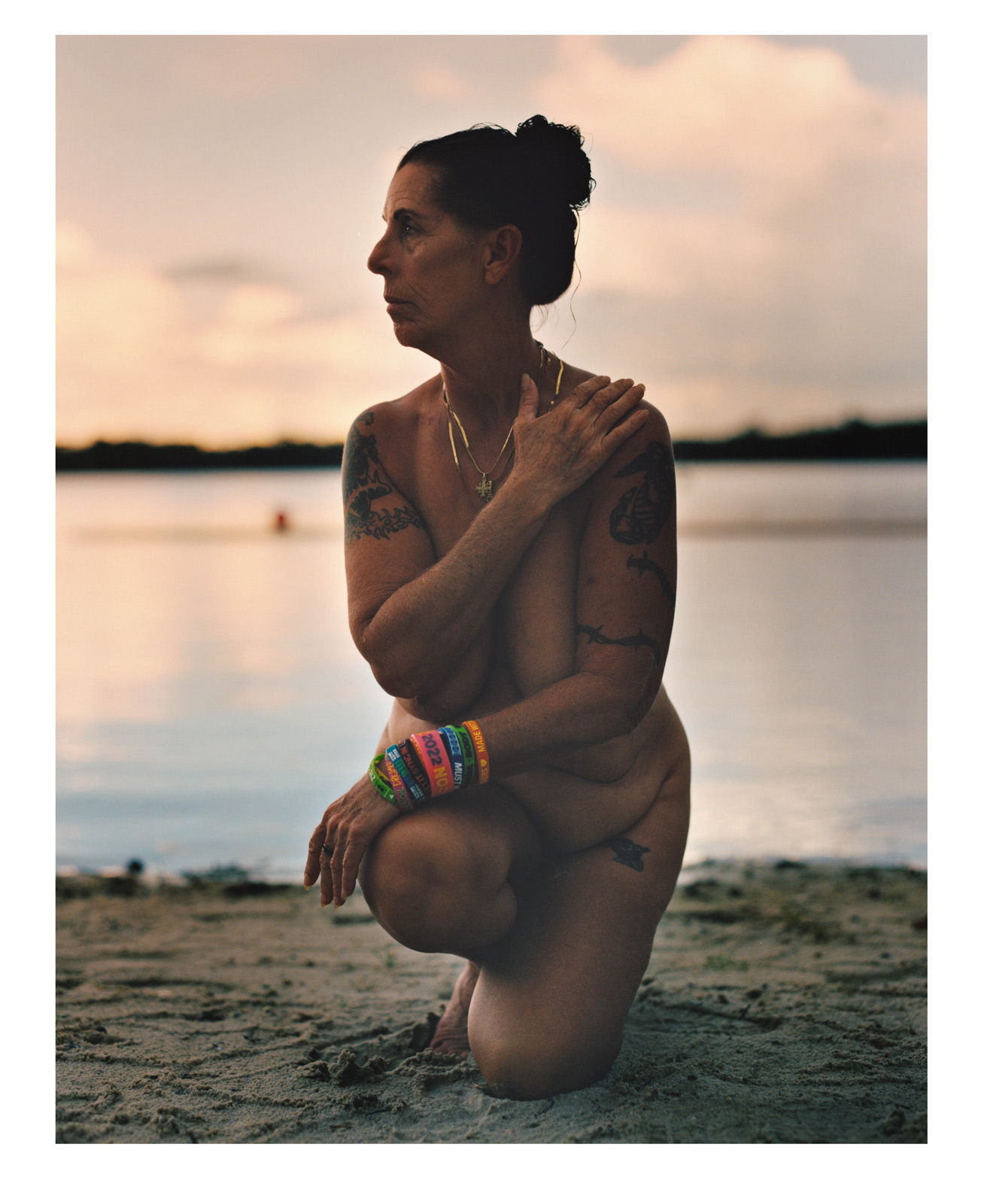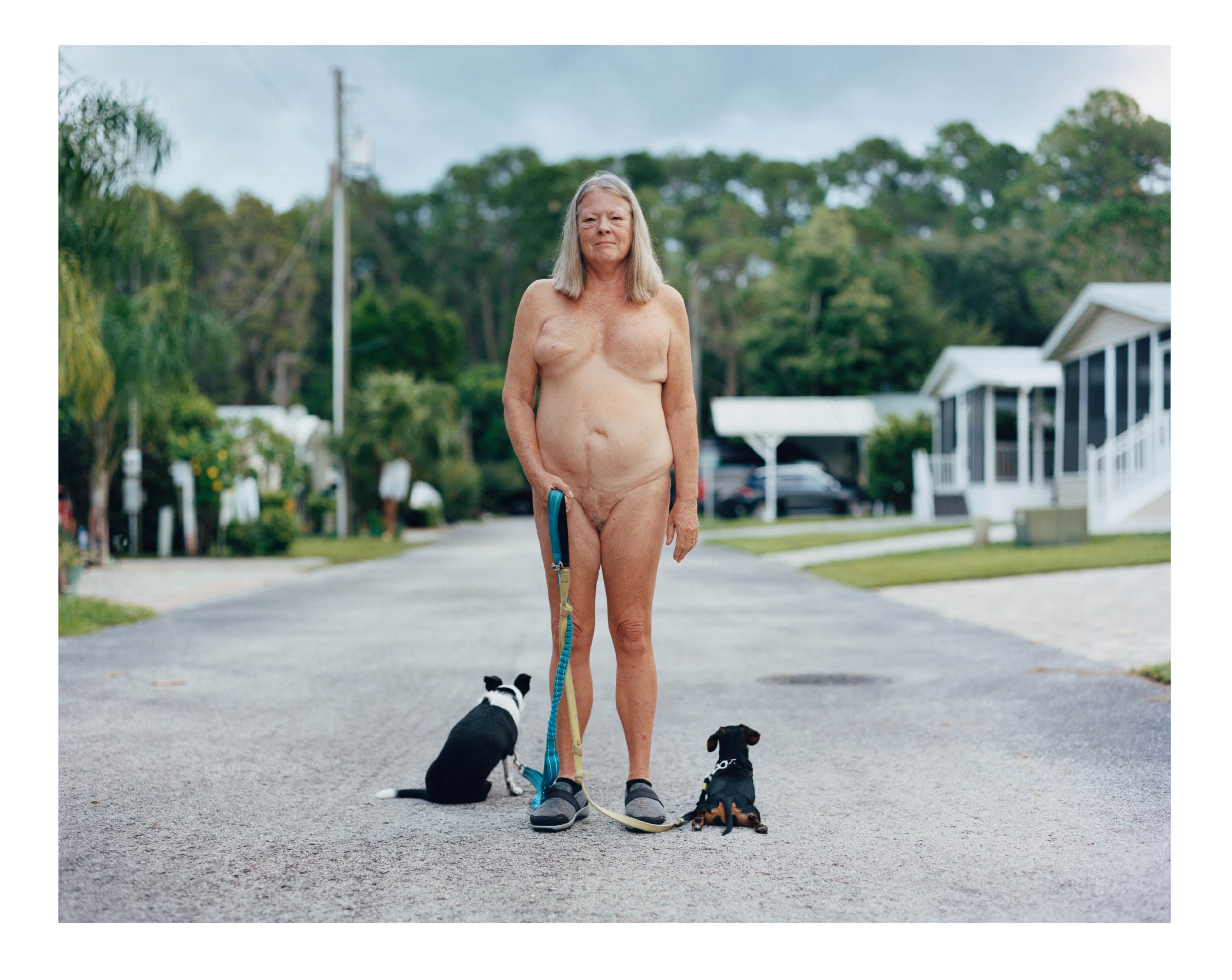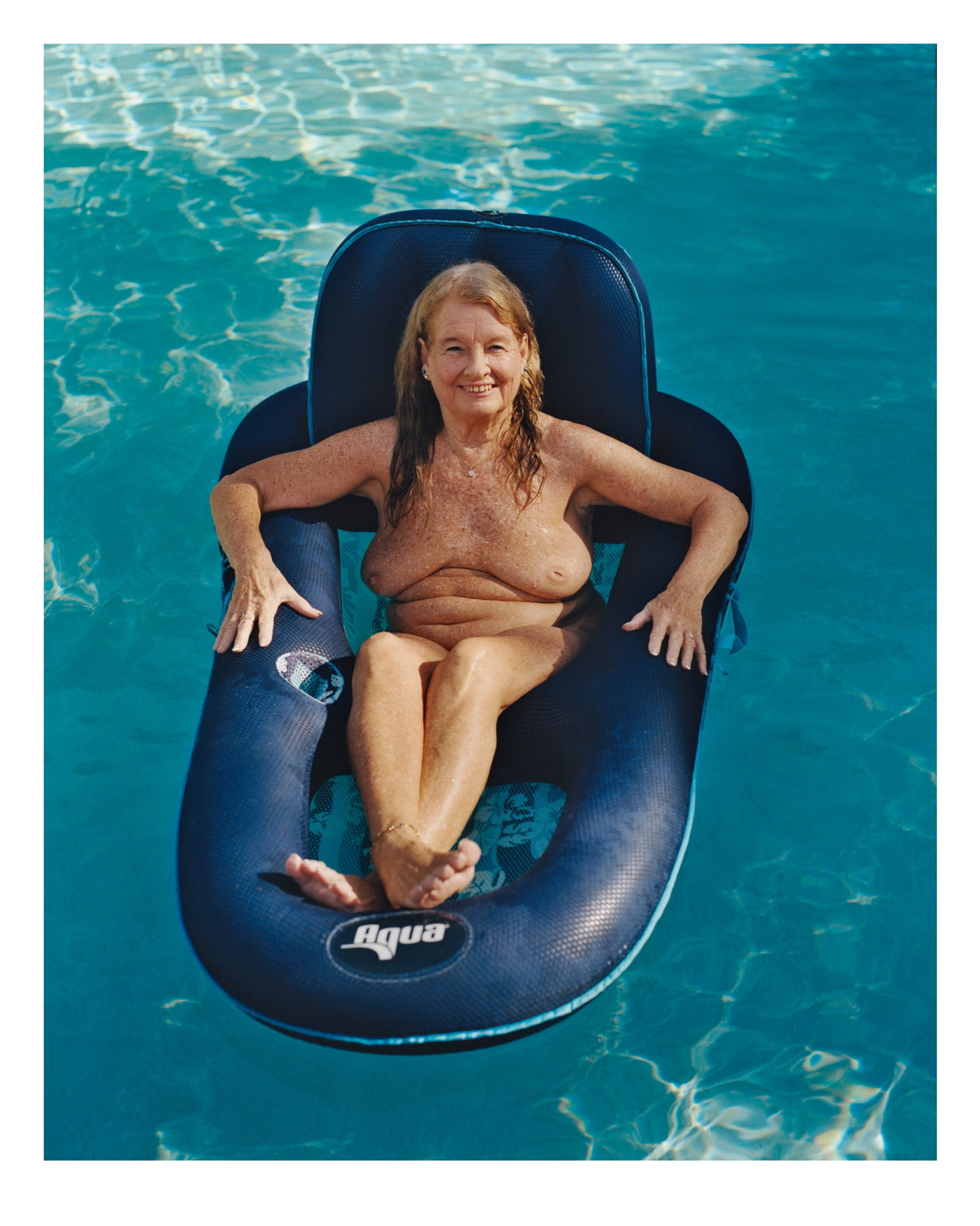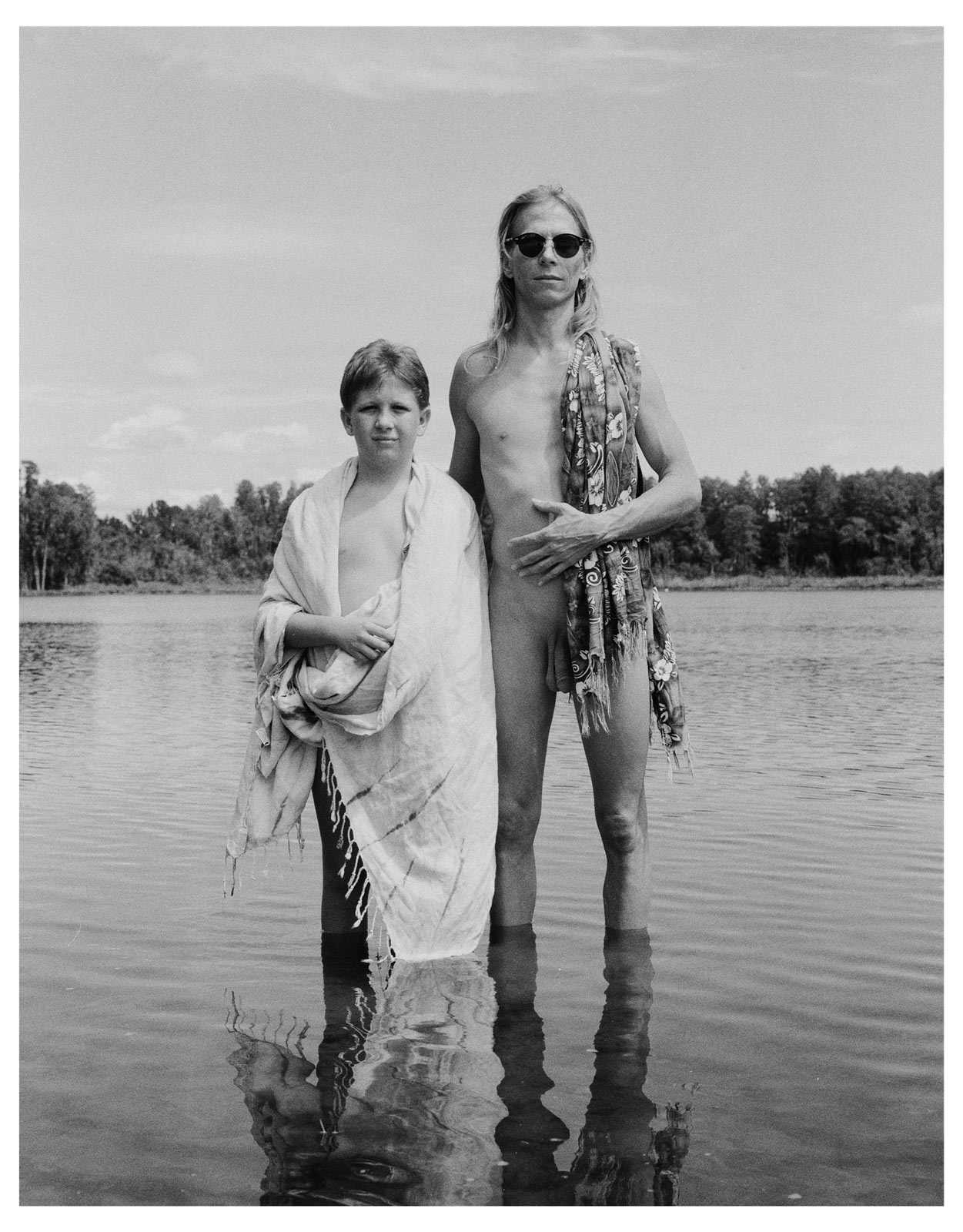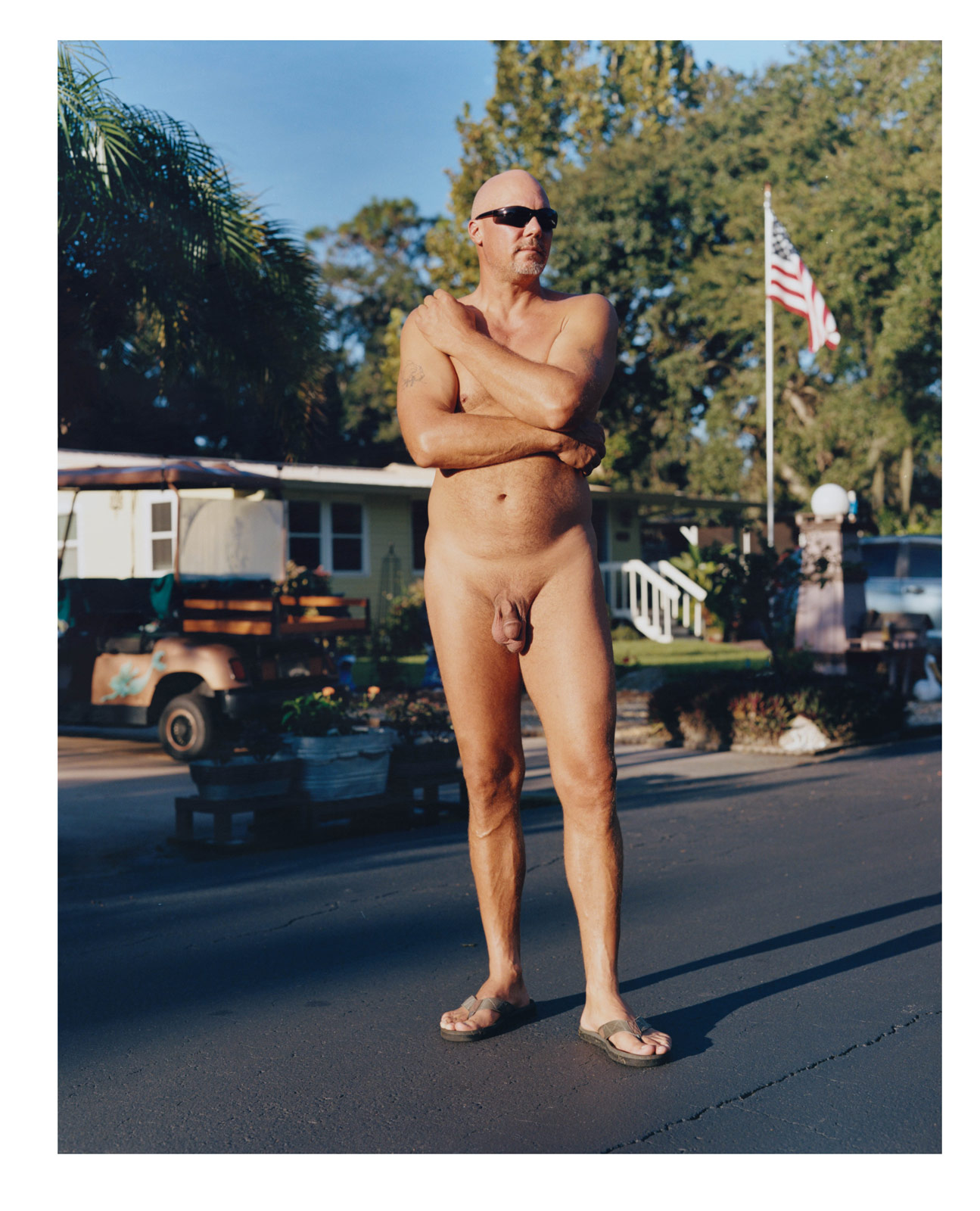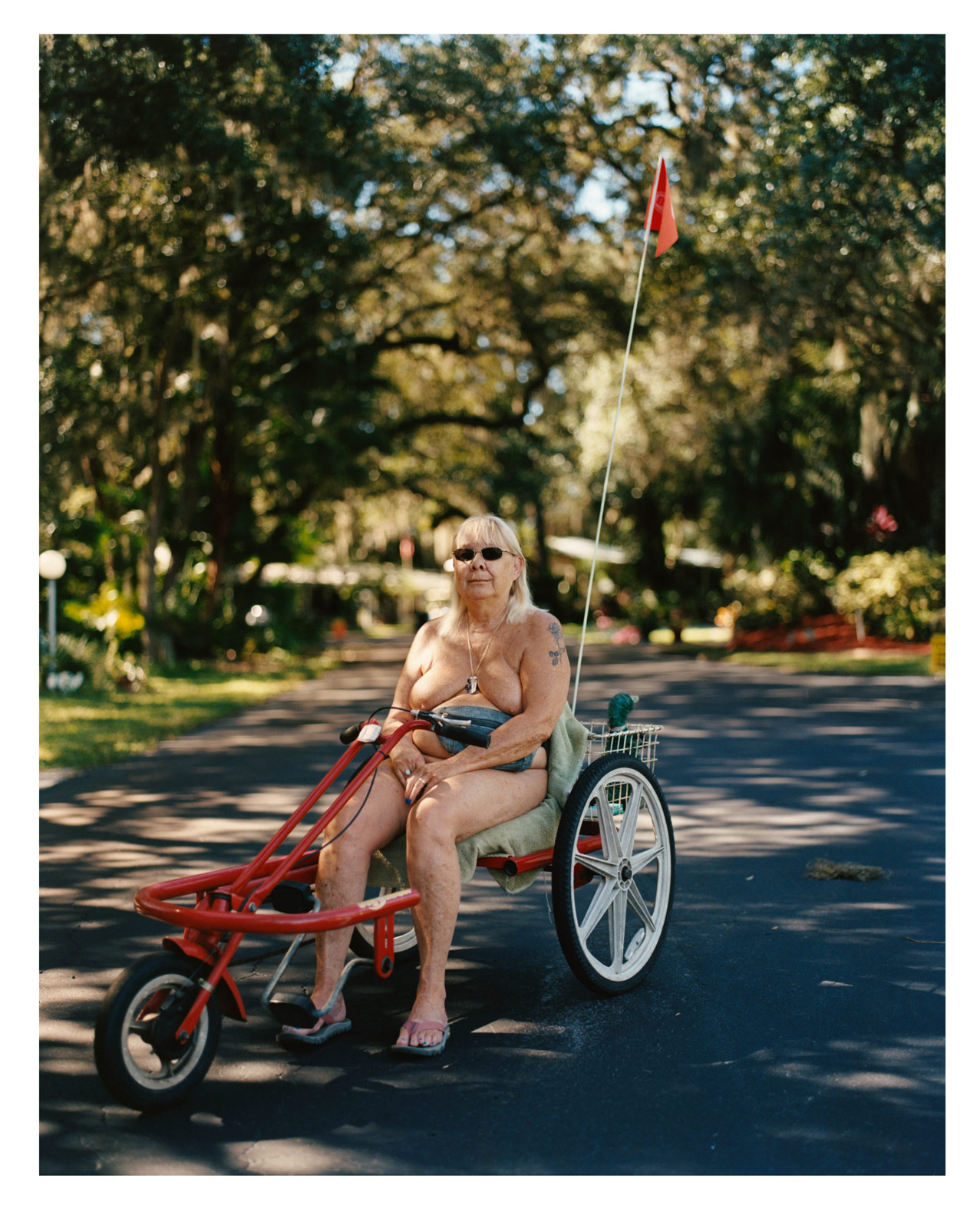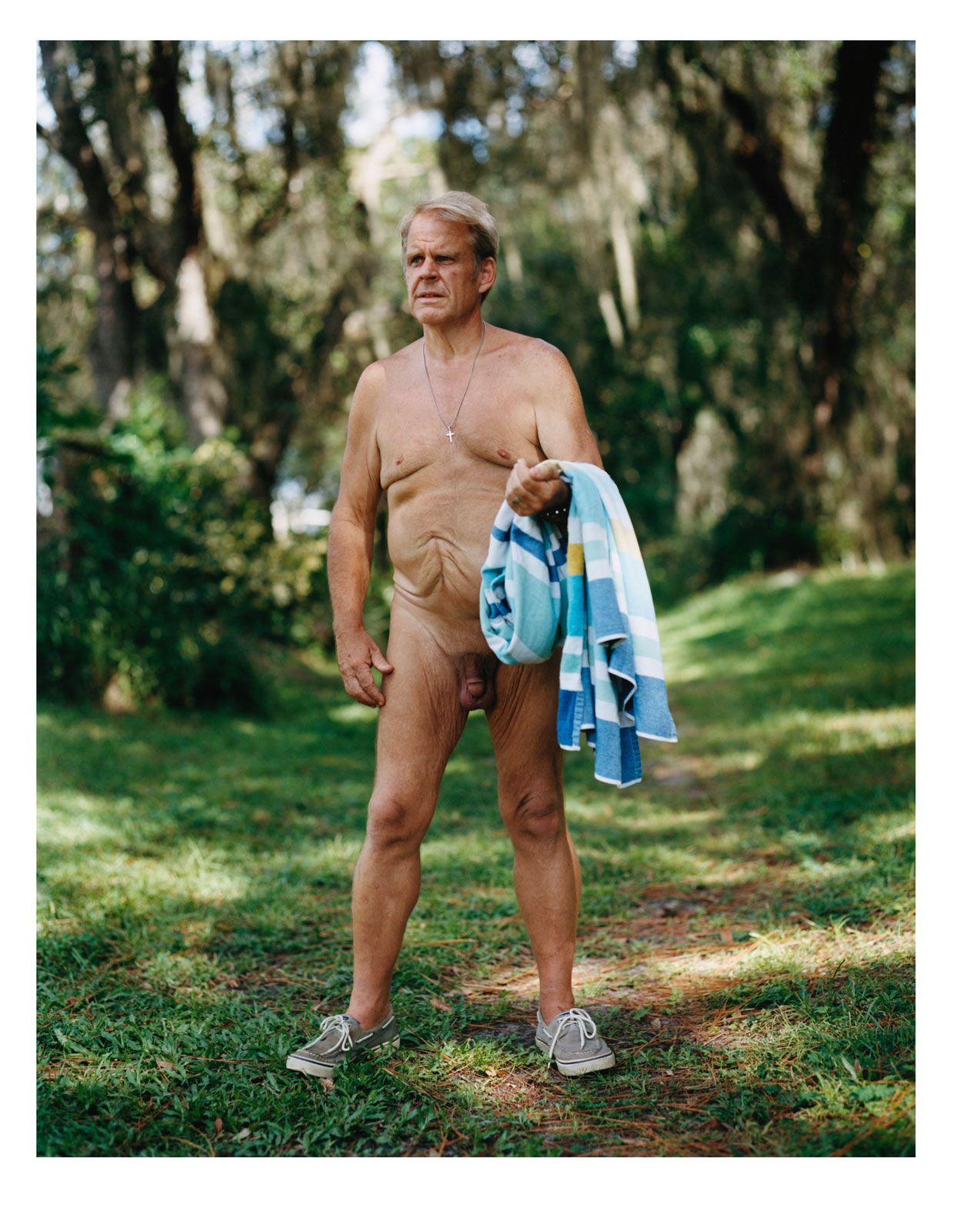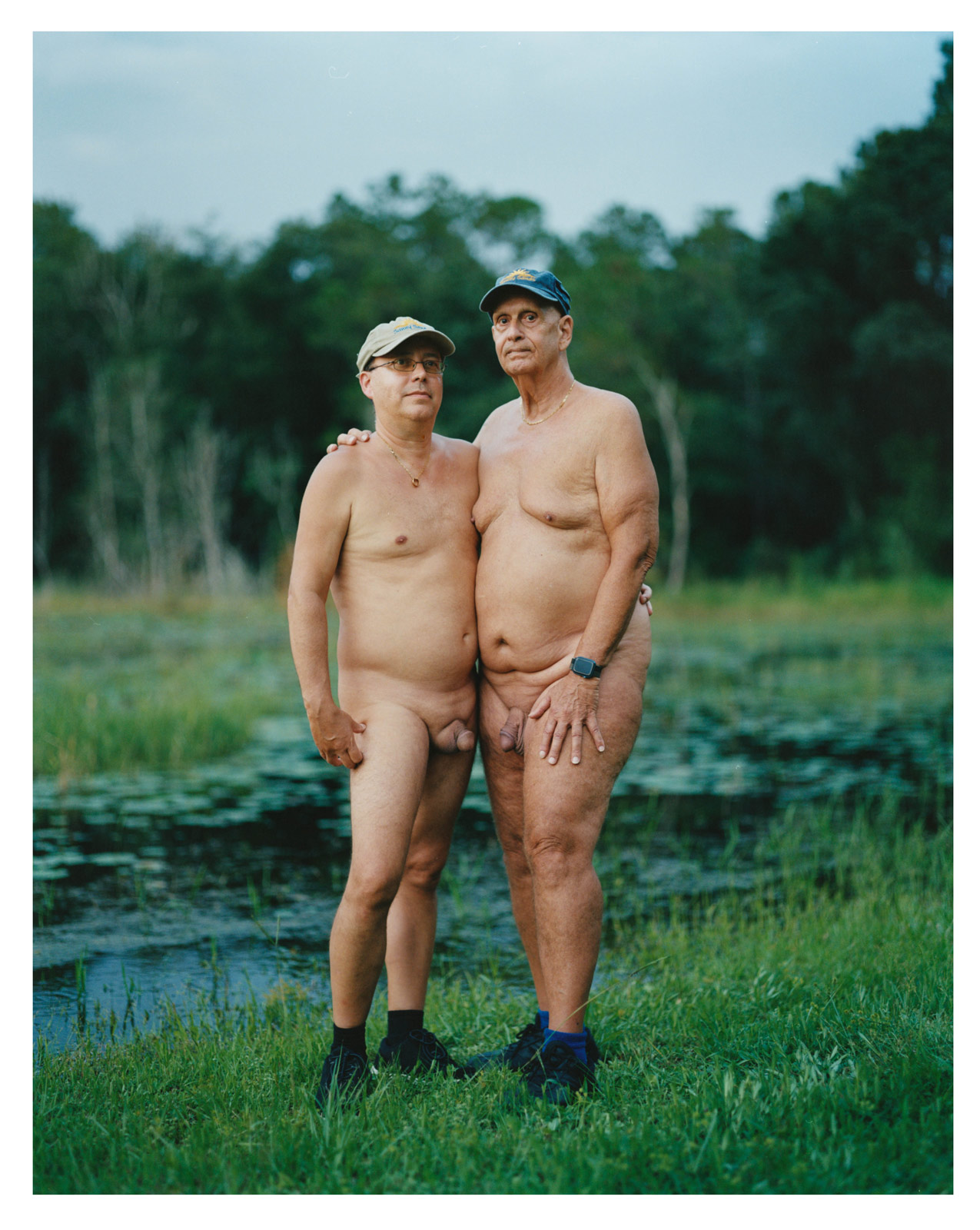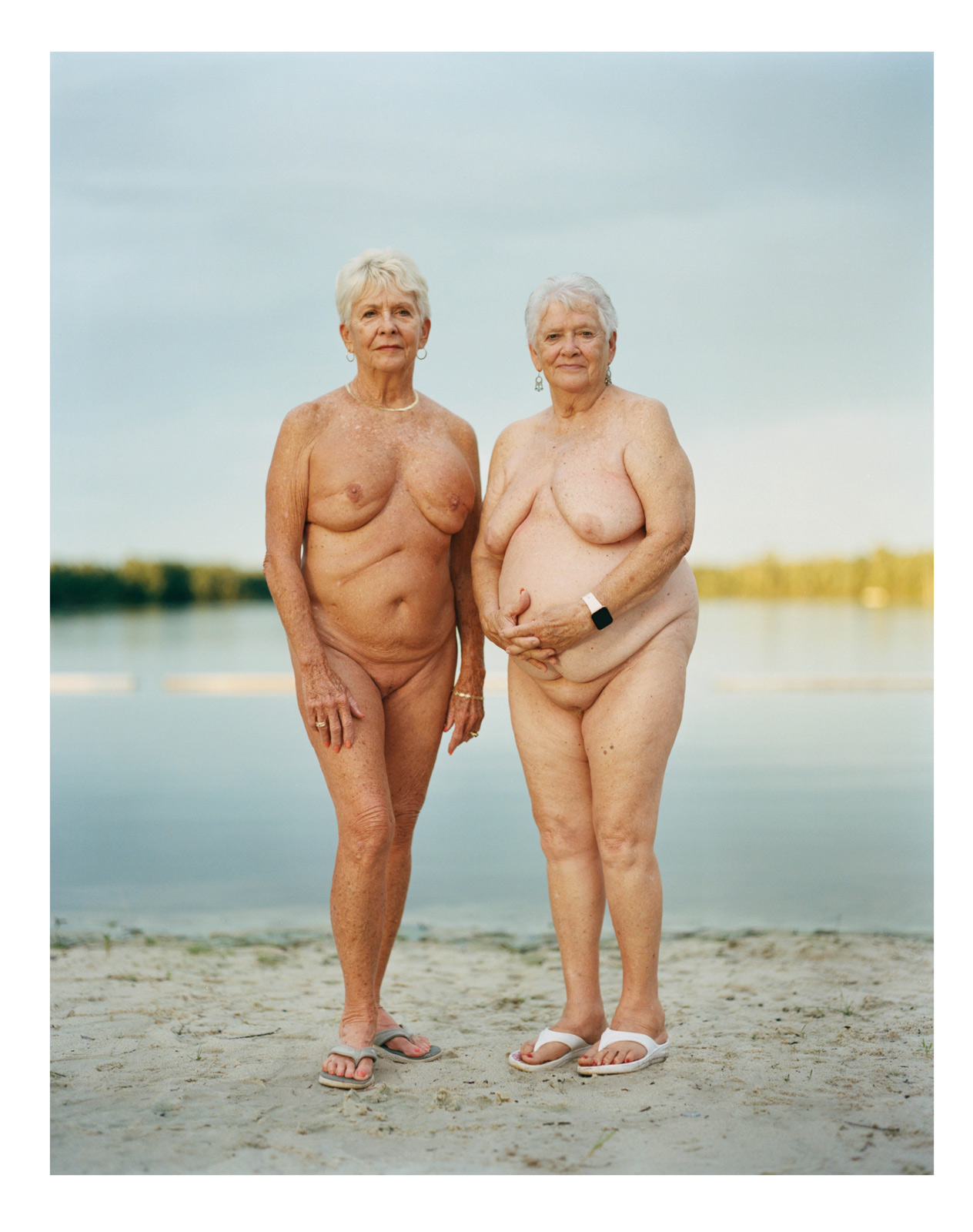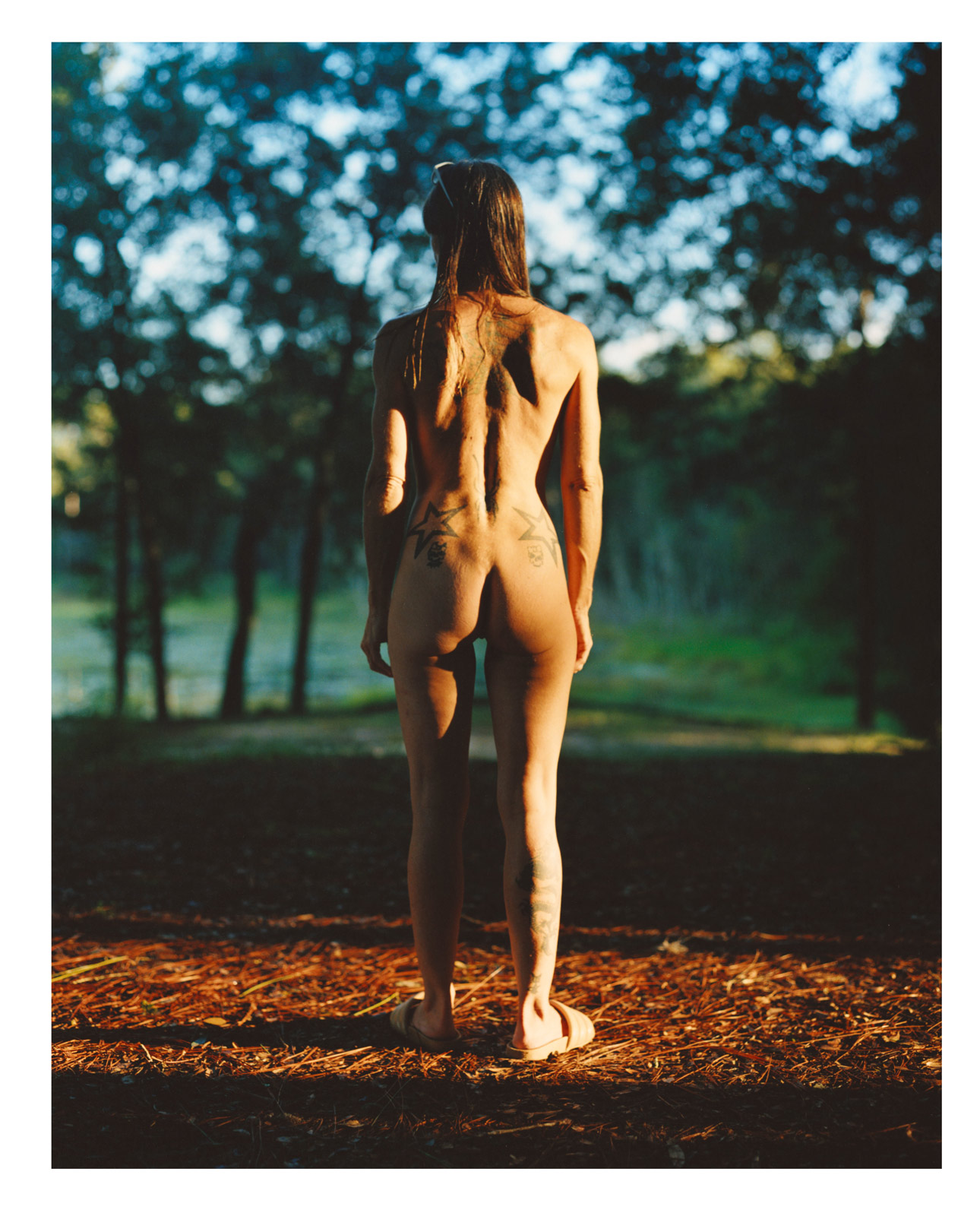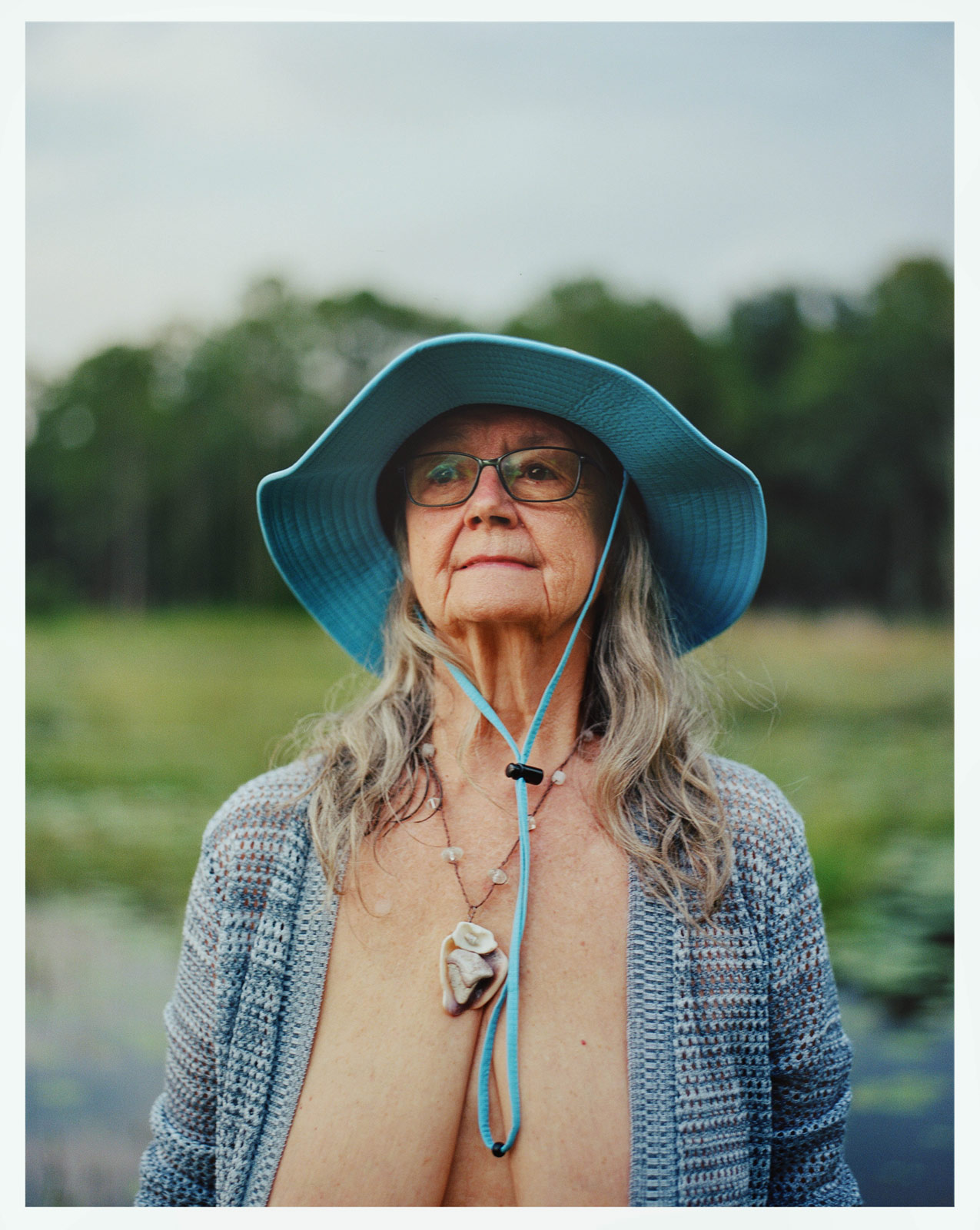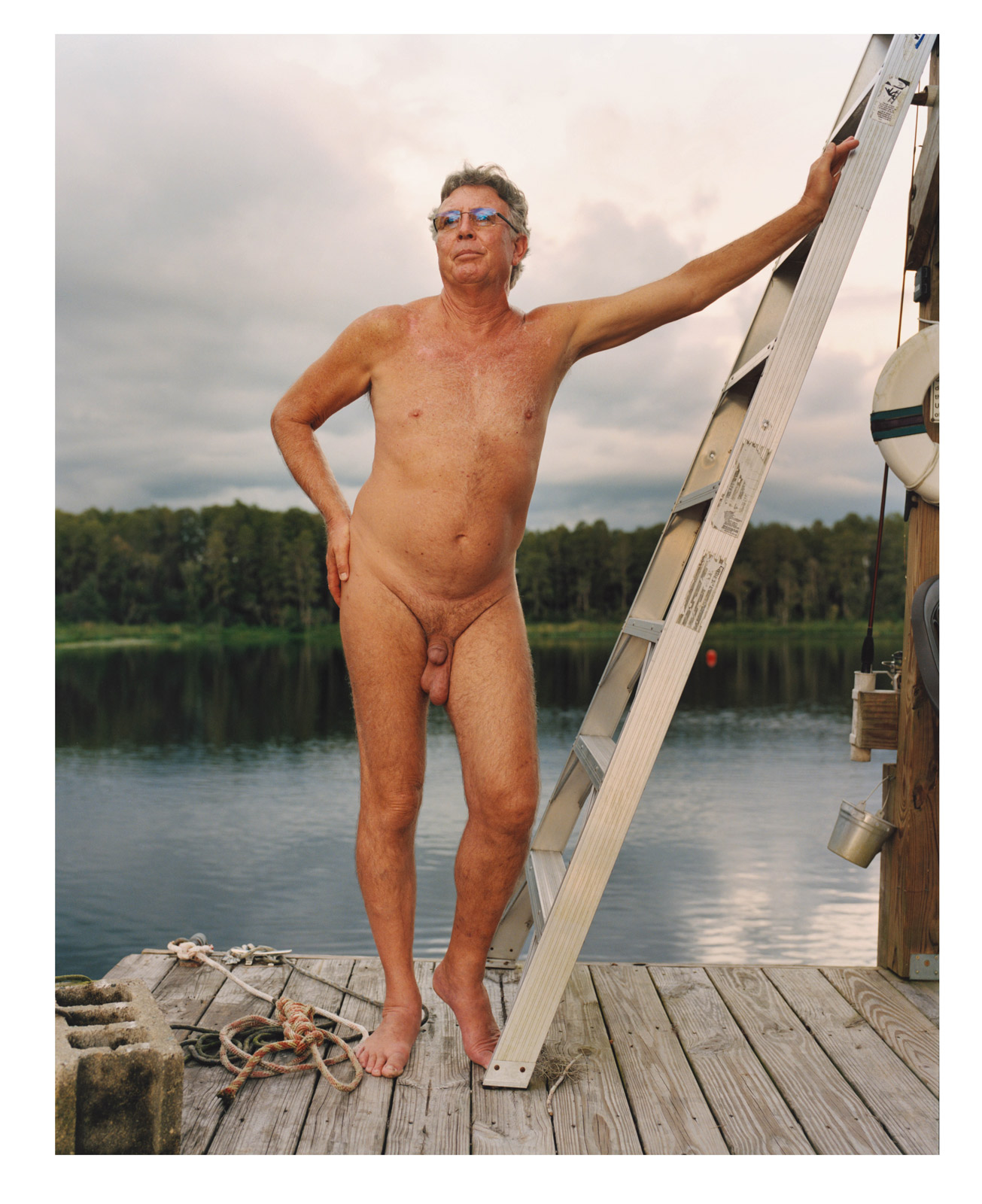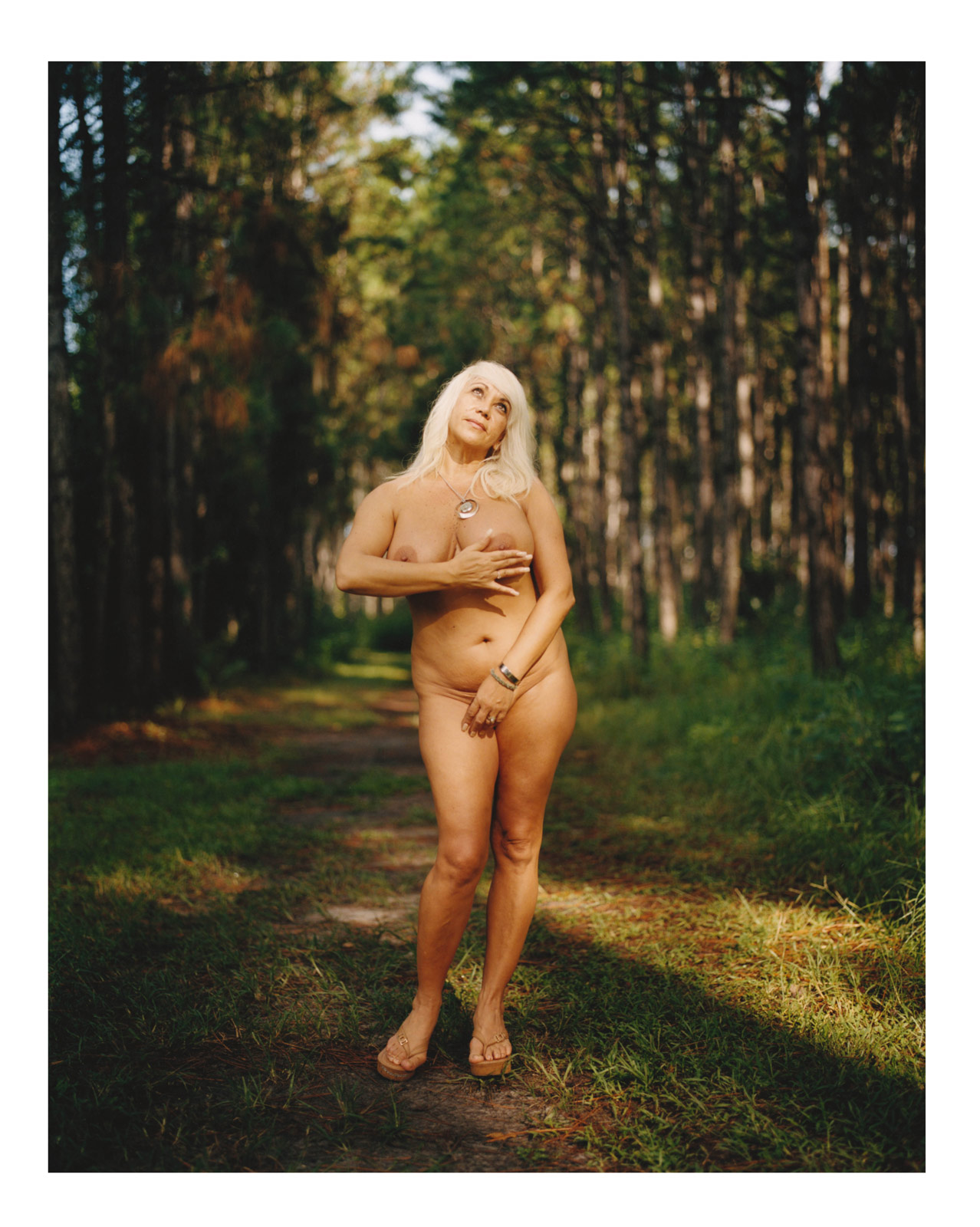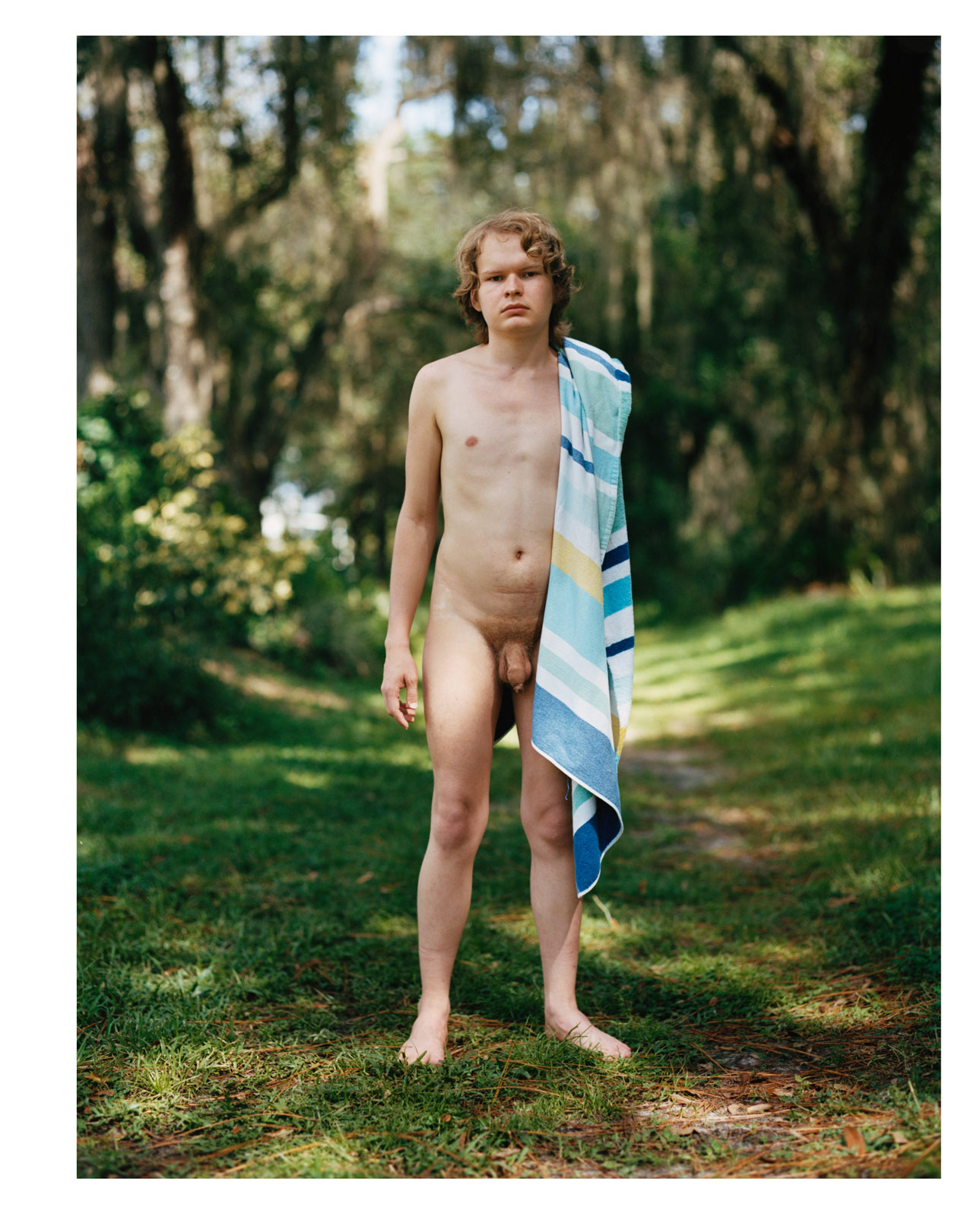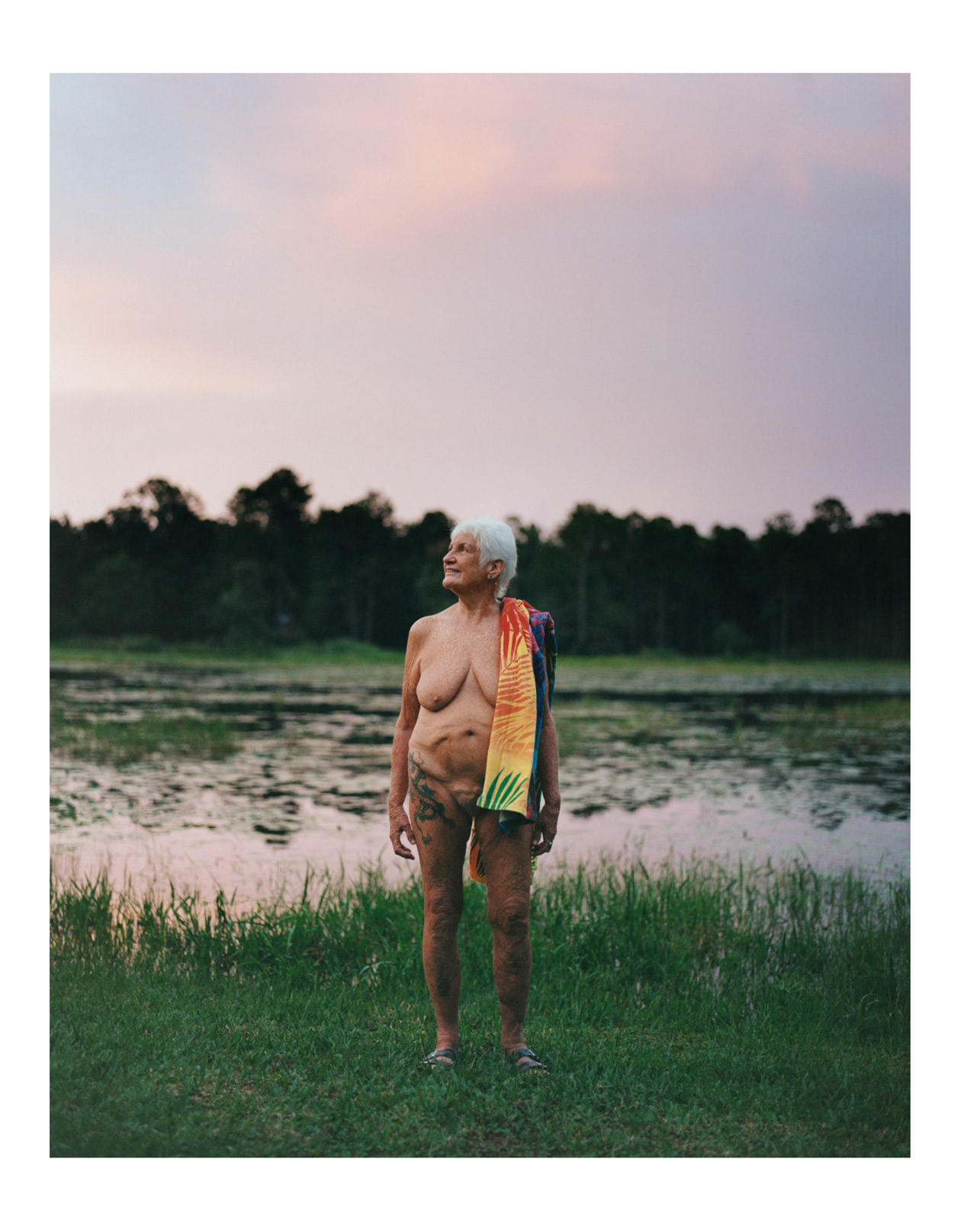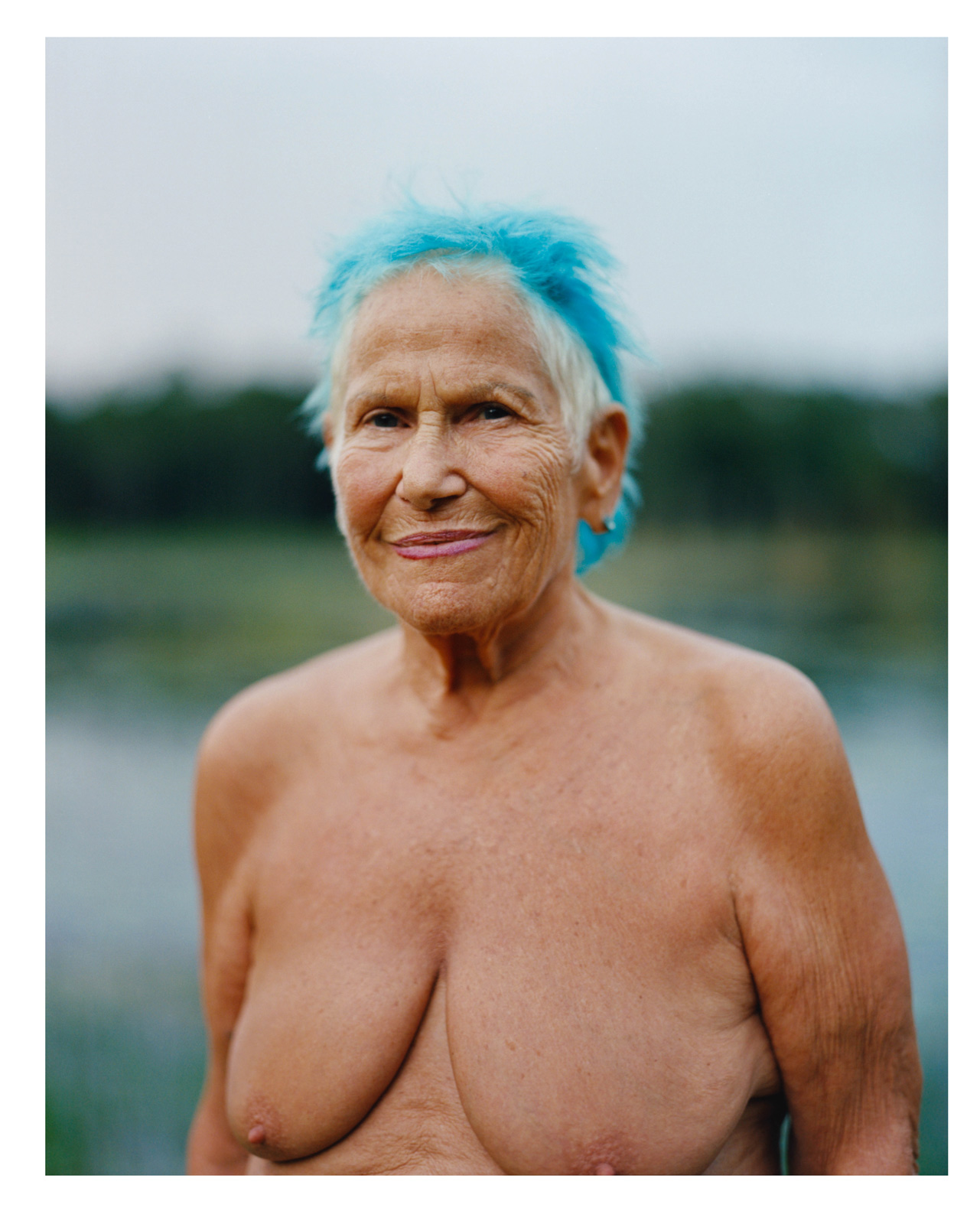
Way down upon the Suwannee River, purists and partiers clash over the movements founding doctrine
Florida calls itself the “Sunshine State,” but that’s just a come-on for tourists. Other states, like New Mexico, get more sun than Florida. The truth is, several Florida cities get more annual rainfall than notoriously-soggy Seattle.
Nevertheless, its near year-round semitropical warmth makes Florida an ideal place for folks whose clothing preference is no clothes at all. “If you enjoy wearing your birthday suit, having warm weather most of the year helps,” said Erich Schuttauf, executive director of the American Association for Nude Recreation. “You can enjoy it 10 months of the year, if not all 12.”
Florida has more nudist clubs, communities, and resorts than any other state—29, while second-place California has just 14, according to Schuttauf. Please do not call them “nudist colonies.” The nudists hate that. Ants live in colonies.
The AANR—the largest and oldest such group for nudists—is itself a Florida resident. It’s based in Kissimmee, not far from where costumed cast members sweat through their days and nights, entertaining kids at Disney World.
Stop by the association’s office sometime, and dip into literature available in the American Nudist Research Library. Be sure to bring a towel to sit on, though. (That’s basic nudist etiquette.) While the library is expansive, it’s lacking in material on the community’s greatest internal rift: the tension between residents who live in the nude for their health, and to fulfill a longing for nature, and those who have—shall we say—other motivations for shucking off their clothes.
The weather isn’t the only reason why so many naked people can be found in Florida. As Mark Haskell Smith, author of Naked at Lunch: The Adventures of a Reluctant Nudist, explained, “You wouldn’t think a state known for conservative politics would be a hotspot for nudism, but there’s also a freewheeling, live-and-let-live attitude, so maybe that helps.”
Florida has catered heavily to tourists since Prohibition. Back then, it was known as the “wettest” state in America, because multiple police agencies looked the other way—or actively helped—as bootleggers transported cargo to their destinations, for a price. That tradition continues with well-heeled nudists.
The state’s nudist communities are designed to appeal to a wide range of naked customers. There’s the crunchy granola, let’s-go-camping aesthetic of Hidden Lake Resort, near the Florida Panhandle town of Jay. There’s the far-more-upscale vibe of Caliente Club & Resorts in Land O’Lakes, with its flashy nightclub and homes that run up to a million dollars. Caliente bills itself as “the most luxurious clothing-optional experience you can imagine,” and “the hottest party on the planet.”
“It’s not cheap,” said Lynn Waddell, who visited more than once while writing her book Fringe Florida: Travels Among Mud Boggers, Furries, Ufologists, Nudists, and Other Lovers of Unconventional Lifestyles.
Even a look-see costs a lot—for men and couples, at least. A Caliente all-day pass for two costs $125. Single males have to pay $175. Single females? $20. For a couple who want to visit all winter, a preferred Snowbird Pass is $2,000. On some occasions, though, Caliente’s management has proven to be generous. When Hurricane Irma bore down on Florida in 2017, they offered to take in evacuees, noting that they need not pack their clothes.
Caliente is just one of several nudist resorts located in Pasco County, north of Tampa. So many communities like it have opened there that the region is now known as the “Nudist Capital of the US.” There’s even a Pasco nudist real estate agent, who specializes in finding suitable homes for those who want to live near—but not in—the resorts. She briefly starred in her own reality TV show, Buying Naked.
It’s one of the reasons Pasco County is ground zero for Florida Weirdness. In Pasco, the Ku Klux Klan signed up for Adopt-A-Highway litter patrol; a group of Wiccans got into a shoot-out with neighbors who thought they were battling Satanists; and two mayors from the same city were arrested within 20 days of each other.
The oldest nudist resort in the state is in Lutz, Pasco—the Lake Como Family Nudist Resort, founded in 1941 as the Florida Athletic and Health Association. Lake Como’s management displays a cheeky, self-aware sense of humor. Its bar is named the Butt Hutt, its restaurant is called the Bare Buns Cafe, and its official newsletter is named The Flash. The resort even features a nondenominational religious service, provided by the Garden of Eden Church.
Yet, Lake Como takes its nakedness seriously. Once a year, the recreation hall offers a display of photos and memorabilia, charting nudism’s ups and downs over the past 80 years.
Nudism first caught on in the US in the ’30s, by way of German immigrants who believed the best way to commune with nature was au naturel. They organized a club called the American League for Physical Culture. Soon, they graduated from naked picnics and skinny-dipping to launch the nation’s first nudist community, known as Sky Farm. It opened in New York’s Hudson River Valley in 1930. By 1931, the club had moved to Dover, New Jersey, and had drawn in 200 dues-paying members. It also drew police raids. However, a judge threw out the charges, finding that members were fine to do as they pleased, as long as they stayed on private property.
The movement spread in the ’40s, picking up speed with the adoption of such popular amenities as RV parking, swimming pools, and tennis courts. Lake Como has those, plus motels, cabins, and camping sites, in addition to a 35-acre lake for sailing and other water sports, a golf course, nature trails, volleyball courts, and—of course—pickleball courts. (Florida has become a hotbed of pickleball players, so much so that one company announced plans to open 15 private facilities across the state. According to Schuttauf, pickleball has supplanted volleyball as the most popular sport for nudists, because it “allows for a much wider range of people to participate. The court is smaller and the action is slightly slower-moving.”)
Florida’s biggest industry is tourism—both clothed and unclothed. A 2017 study by Saint Leo University, paid for by the AANR, estimated that an annual 2.2 million nudists visit resorts and beaches across the state, and take nude cruises from Florida ports. All in all, they contribute more than $7 billion to Florida’s economy each year. Rental cars, flights, gasoline, meals—it all adds up.
“My wife and I just went on a nude cruise,” Schuttauf said. “A chartered ship with 2,500 people on it.”
Over the past 80 years, some things have changed for nudists—both in Florida and beyond. In the old days, people often used pseudonyms or first names only, Schuttauf said. Now, they are more likely to feel comfortable using their real names, both first and last.
Nudist magazines were once the only source of information about resorts, and directions to them would contain cryptic notes, such as, “Turn at the third mailbox.” Now, he said, in addition to resort websites, there are GPS directions and apps for your phone.
The resorts have been forced to institute policies about where and when guests can use cell phones, Schuttauf continued—in part to limit where and when photos might be taken. And more recently, they’ve had to develop codes about modern trends in body jewelry.
One other change since the ’30s and ’40s is the practice of always bringing something to sit on. “If you look at pictures from the old days,” Schuttauf said, “nobody’s carrying a towel.”
“Florida’s biggest industry is tourism—both clothed and unclothed. A 2017 study by Saint Leo University, paid for by the AANR, estimated that an annual 2.2 million nudists visit resorts and beaches across the state, and take nude cruises from Florida ports. All in all, they contribute more than $7 billion to Florida’s economy each year.”
According to both Smith and Waddell, nudists tend to be white, well-off Baby Boomers. Few, if any, are Black, they said, and the resorts seem to attract close to no Asian visitors at all.
Many are retirees ready to throw off society’s conventions, and their old workforce wardrobes. Only a few resorts, such as Caliente, work to attract a younger crowd—one that’s ready to spend plenty of money on a good time.
Schuttauf contended that there are also communities aimed at younger nudists, college-age to 30. And, he said, Black nudists are “one of our fastest-growing groups.” At this point, though, they tend to organize their own get-togethers, such as nude cruises to Jamaica, rather than merge with white-dominated groups.
Given the nudists’ spending power, no matter the color of their skin, it’s a small wonder that generally-conservative Pasco County politicians have no complaints when Lake Como sponsors its Dare to Go Bare 5K, which attracts about 150 competitors.
Dealing with the COVID pandemic was as big a challenge for nudist resorts as it was for what they would call “textile” hotels and campgrounds. People who would normally wear nothing had to don masks.
“We’ll have tan lines, but in a different place,” Schuttauf joked to the Washington Post.
In the pandemic’s first year, mandatory lockdown upset the normal order of business. For instance, Lake Como could only accommodate its 200 year-round residents. Locked out were the 800 nude tourists who vacation there each year.
At Hidden Lake, the owner only allowed visitors who had recently arrived from New York, Canada, and Illinois to stay on during the shutdown. He had to cancel pages and pages of other reservations.
Some attractions had to temporarily close—the Butt Hutt, for instance, as well as gyms and swimming pools. Others adapted by adopting new rules. At the golf course at Cypress Cove Nudist Resort in Kissimmee, play could continue, but no one was allowed to touch anyone else’s balls.
As businesses reopened, some resorts made changes. Caliente, for instance, installed new hand sanitizer stations and menu boards, increased cleaning, offered only disposable cutlery, and purchased thermal imaging cameras to check body temperatures.
The resort also suggested a behavioral alteration: “We know our members and guests often greet each other with a hug and a kiss. […] We might suggest embracing the butt bump. It’s more fun than the elbow bump and doubles as a great move on the dance floor.”
Not all nudist resorts share the same philosophy when it comes to operations. Some are open to the whole family—children included—so that multiple generations are compelled to return over and over.
Some are for adults only, period. No children allowed.
Some subscribe to pure “naturism”—nudity for its own sake. This was the doctrine of the founders of the nudist movement, and many followers still practice it religiously. They believe that removing your clothes makes you more open to the health benefits of the earth and atmosphere.
Some are fine with incorporating what American culture usually associates with nudity—namely, sex. Advocates for sex-positive nudist resorts, including those allowing multiple sexual partners, do not appear to be as numerous as the straight-up naturists—but they do exist. The tension between these two groups—call it the purists versus the partiers—can simmer quietly under the surface for years before spilling out in public.
In 2008, the AANR, which promotes the family-friendly side of nudism, clashed openly with the owners of Caliente over its aggressive marketing to swingers.
“The association temporarily suspended Caliente’s membership in May after the club registered to have a booth at an adult trade show, Swingfest,” a local paper reported. A Caliente spokeswoman complained that the association “hasn’t kept up with the times.”
But the quarrel didn’t start with Caliente and the AANR. It began as an internal struggle between management and Caliente homeowners, noted the paper. Longtime residents weren’t happy with the resort’s attempts to attract wealthy visitors, who were more interested in possibly scoring with multiple sexual partners than in sloughing off their clothes to bask in the sun.
Waddell referred to the latter group as “nude tourists”—people who just want to visit and stare, rather than stay and become part of the community.
“The residents tend to be more purist,” Waddell said. “They are resistant to people who assume nudity is all about sex, so they don’t like the insinuation that that’s the goal. They don’t want people to come out there just to gawk.” But aside from complaining, she said, no one ever did anything about it—such as organizing a nude picket line.
Longtime nudists regard fellow nudists as part of their family. Paula Wheeler says that’s what attracted her to the Suwannee Valley Resort in White Springs, which claims the title, “North Florida’s Premier Clothing-Optional Resort.”
When she arrived a year ago, she “fell in love with it,” she said. “Anything you need, they’re ready to help out with—whether it’s dog-walking or asking, ‘Do you have a tomato for the salad?’ We’re all very, very tight.”
Because the owner is ex-military, Suwannee Valley offers discounts for veterans and first responders. And there are fundraisers to help pay for veterans’ medical care, where it’s not already covered by the government.
Florida’s official state song is “Old Folks at Home”—the one about being “way down upon the Suwannee River.” Although it was written by a composer who never set foot in Florida, the state has embraced it. A bridge over the Suwannee even bears the musical notation and lyrics of the song’s opening.
Given the state’s popularity among nudists, it makes sense that there is a nudist resort on the river itself—one occupied by about 40 people. But because it’s frequently traversed by clothes-wearing canoeists, kayakers, boaters, and anglers, Suwannee Valley residents have to get dressed before approaching the waterfront. A sign there warns that remaining nude in full view of the non-nude public may bring repercussions—or, at least, unwanted visitors.
Wheeler said that these strictly-enforced rules are one of the reasons she likes Suwannee Valley. The resort is for the over-21 crowd only—and she’s glad to see that, because she would feel uncomfortable remaining nude around children. “We also don’t allow swinger activity,” she continued, suggesting that other resorts may have this as a rule, but enforcement is lax. Not so at Suwannee Valley.
The Suwannee Valley Resort, by the way, was founded by a group of nudists with a secondary interest that unites them. They call themselves the Bare Buns Biker Club. You can’t beat that as an expression of Florida’s freewheeling spirit.
Nancy Dudash, 56 (Left)
In February 2011, a friend introduced Nancy, a retired Army nurse, to the Maryland Health Society’s resort MAHESO in Annapolis, Maryland.
Tracy Bowen, 50 (Right)
“My first experience with nudism was with my husband at Avalon in 2006. We then traveled to different resorts, meeting new people and making lifelong friends. We found our home seven years ago in Sunny Sands, Florida, and have not looked back. There is nothing to hide when you are naked.”
Left: Cathy Merritt, 63
“We went to a nudist resort with friends. I figured I would try it, and I fell in love with it. When we retired, we looked for a resort to move to. It’s the freedom of acceptance, not based on looks or body image. I am now a certified water aerobics and senior fitness instructor—enjoying this life very much.”
Right: Gilbert, 67 (Left), and Mildred, 59 (Right)
“When we were kids, we would go skinny-dipping with our friends. We always felt comfortable without our clothes. We used to get sun on secluded beaches.
We heard about the AANR from someone on the beach, joined shortly after, and we have been members since.”
Left: Herman (Left) and his wife (Right)
“I was introduced to the nudist lifestyle by a friend, Ted Hadley. What made it attractive was that there was no judgment around what body type you had. I was picked on for being skinny when I was younger, [and nudism] helped me become comfortable with how I look.”
DJ Skyclad, 40
“Since I was a child running wild, nude in my backyard, I’ve been a naturist at heart. At the age of 12, I realized my love for naturism and expressed to my parents that, one day, I’d live in a nudist community. At 28, while job hunting as a massage therapist, I discovered my first nudist resort. The rest is history.”
Left: Lynda Myers, 68
“I became a nudist in my late- 30s, after I became a massage therapist. I went to work at a local nudist resort outside Denver. I moved to Como in ’98, after I found out you could live the lifestyle full-time.
Within months of moving there, I was diagnosed with a rare form of breast cancer, and I did an experimental stem cell treatment. I didn’t have any family or longtime friends, so Como stood by me. One lady would drop off a bag of groceries or a $20 bill. They had a fundraiser for me, and I had a list of people I could call for hospital rides in the middle of the night if I had a 102 degree fever. Como is a place where single women can feel safe and watched over.”
Peg Lane, 69
“I’m the previous owner of Juniper Woods, a nudist campground in Catskill, New York; [my partner] Jim and I are continuing our nudist lifestyle [by retiring to] Sunny Sands.”
Left: Aimée Stritt, 39
“There are so many great reasons to get into nudism. To me, the most important thing is the confidence that it’s brought me and my family: the ability to be seen for who you are—not who our ‘society shackles’ (clothing) show us to be—and the understanding that less is truly more in this world! I would still be in a very dark place without nudism.”
Right: Jason Koczenasz, 50
“Five years ago, I learned about a nudist resort next door to the community I bought a house in. I was curious about it. I visited, and I met the most pleasant people. I’d never felt so welcomed by new friends.”
Left: Craig Ardolino (Left) and Joe Ardolino (Right)
“As fate would have it, Joe and I met 37 years ago and marveled that we were both raised by nudist families. I was brought up in a house on a naked beach on the East End of Long Island, while Joe grew up on the opposite fork, where his family would frequent nude beaches in the summer.
Our years together haven’t just been about being naked, but also about enjoying nature with walks through the forest or hikes in the mountains— enjoying the beauty of life while free from clothes and social restraints. Amazingly, we discovered that our families taught us the same values: to embrace ourselves for who we are, not for what others want us to be. That, to us, is the core of living life as a nudist.”
Right: Maryalice Greene, 78 (Left)
“When I met my second husband, he invited me to a nudist resort. I had never been, and did not want to take off my clothes. When I went with him to Cypress Cove, which is where he lived, I met a lot of friendly people. Soon, nudism was part of my life.”
Carolyn Hawkins, 79 (Right)
“In 1979, I met my second husband and relocated to Florida. We ended up residing in Cypress Cove Resort, after my first nudist experience at Assateague Beach, Virginia. The transition was easy, since Assateague was so rewarding. It gave me a lot of confidence and freed me of many inhibitions—so much so that now, nudity is second nature.”
Left: Rebecca Leroy
“I was raised by two of the most beautiful nudists in the world! They taught me how to love myself, how to love others, and how to love nature. They also taught me to embrace my thoughts, accept my feelings, and appreciate my body. Nudity was normal throughout my childhood. I realized that it was not considered normal once I became more social—it’s something that most people consider sexual, shameful, and inappropriate.
As I matured, I quickly realized that I had a very different view of my body from most of my peers. Their lack of confidence seemed directly related to how their bodies looked. It was at this age that I realized the advantage I had been given through my upbringing. I wasn’t struggling with my self- confidence. I wasn’t trying to make my body fit the image of anyone else’s. I understood that my body wasn’t my worth. I wasn’t focused on fixing myself; I had already accepted who I am wholeheartedly.”
Right: Sherry Judd, 76
“In the late-’90s, my husband introduced me to the lifestyle. I was skeptical about it, but when I got to Solair, I realized that it was a wonderful way to live. Now, I have the privilege of introducing other people to our community and sharing our lifestyle with them through tours.”
Left: Jack Clark, 66
“I grew up very shy and, for the most part, a loner. Education became my focus—my escape. I always had the inclination to be nude, but it felt morally wrong and I did not know how to approach it. When I moved to Florida from Rhode Island, I felt the distance from home gave me a little more freedom. I finally built the nerve to search out Playalinda Beach, on the Cape Canaveral National Seashore. I walked out to the beach, got settled in, and took my shorts off. In an instant, I felt my insides turn 180 degrees—and I felt comfortable. For once, all I had to be was myself. It opened a new and wonderful life for me, which led me to Lake Como. It felt like home the second I came through the gates. I found such wonderful friends, who are now our neighbors. Some have moved on, but we’re still like a big family. It also gave me the fortune of meeting my wife, Maryanne, and we have built a home and a wonderful life here.”
Right: Alicia Moses, 53
“I’ve always privately felt more at ease being nude; it was a way for me to remove the pressures of dressed society. In the textile world, we’re constantly having to worry about what to wear. Being a member of a recognized nudist association gave me a sense of being judged on how I conducted myself—on how I treated others. I had no idea there were places where you could be at ease while in the nude, feeling safe.
I was in a car accident, and it deformed my body—I was forced to have my internal and external breast areas reconstructed. During the healing process, I was most comfortable in places like Lake Como, where it’s truly about naturism. Its core [value]—safety—allows family to be at the forefront, while the commonality is ‘real nudism,’ which is about not judging how others look. Nor is there sexual prowess. It’s about being safe, secure, and healing in nature while in the nude.”
Left: Maxwell Schuttauf, 21
“My father has worked for the AANR since before I was born. I have been to dozens of resorts throughout my life, and I work with him to promote nude recreation throughout North America.”
Right: Alice Gauthier, 87
Alice has been a nudist for 60 years and has lived in many different nudist communities.
Ralph
Before becoming president, Ralph served as a trustee and director at the AANR headquarters. He’s been involved with the naturist community for over 18 years. During Ralph’s term, he’s helped to acquire a new naturist beach in Florida.
Rob Seriff, 66
“I probably [found] nudism like many people do—skinny-dipping in a lake and air-drying in the sunshine. I pulled together a small group of friends and we booked a charter in the Bahamas. We enjoyed nude sunbathing and sailboarding. There’s nothing like standing naked on the bow of a sailboat, while plowing through the waves with the wind in your hair! After that, I spent years without going nude outdoors, because I didn’t know where I might find a place to do so without getting arrested. Then, I read an article about the AANR. To my surprise, there were three AANR- listed nudist resorts within a reasonable driving distance. I contacted one of them, and offered to tether my hot air balloon to give rides during National Nude Week.
Here I am, 25 years later. Once you’ve felt the freedom of life clothing-free, it’s hard to go back.”
Serena Stirone, 74
“While living in California, I met a friend who was visiting Glen Eden. Finally, after six months, she took me with her. Being involved in nudist communities has been a wonderful way to meet new people.”


